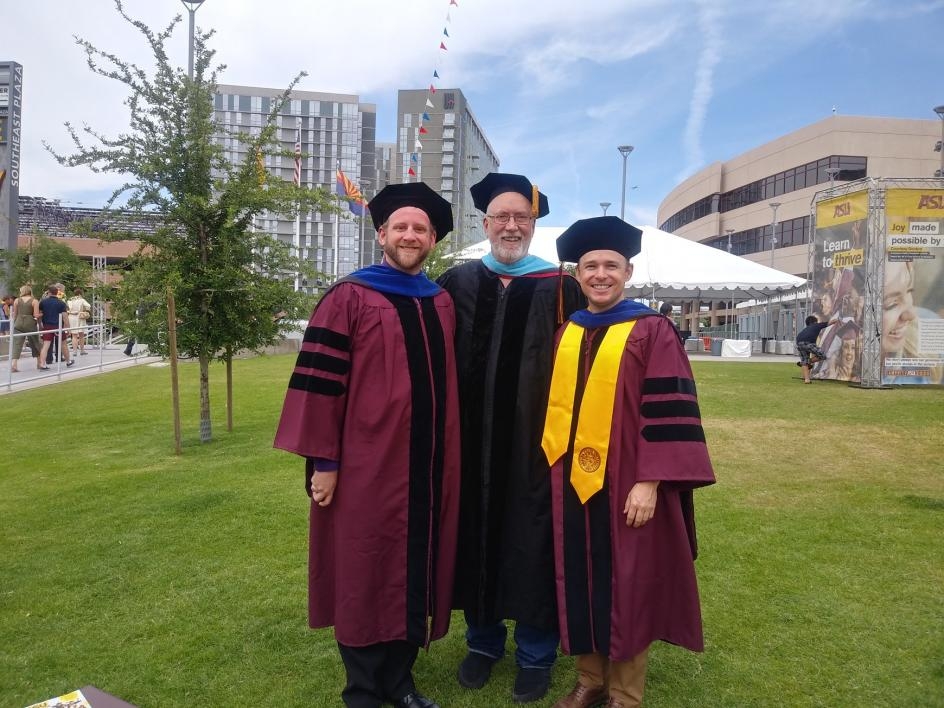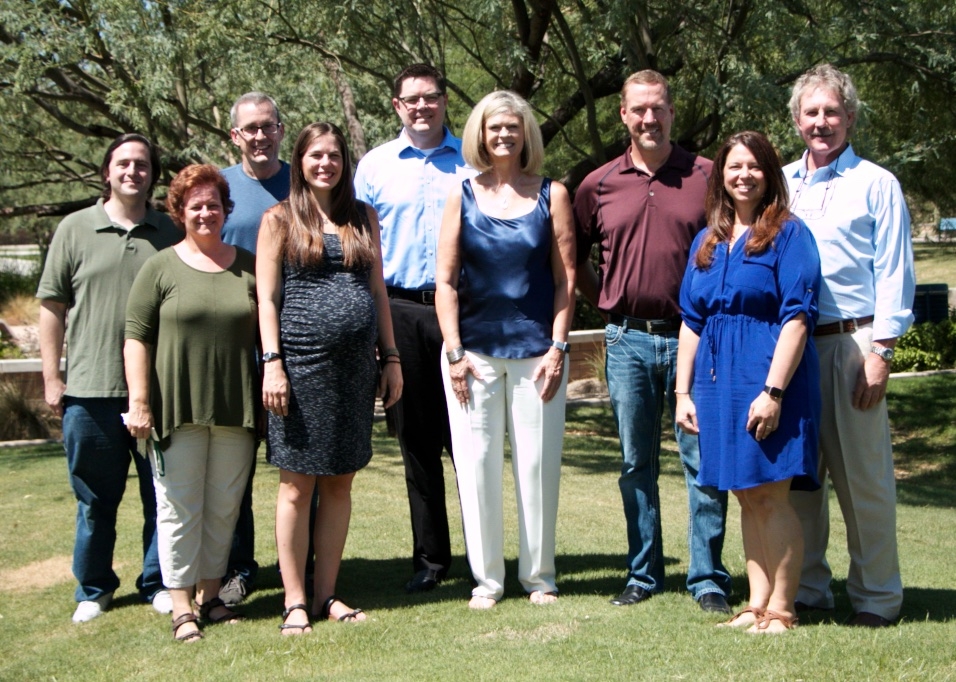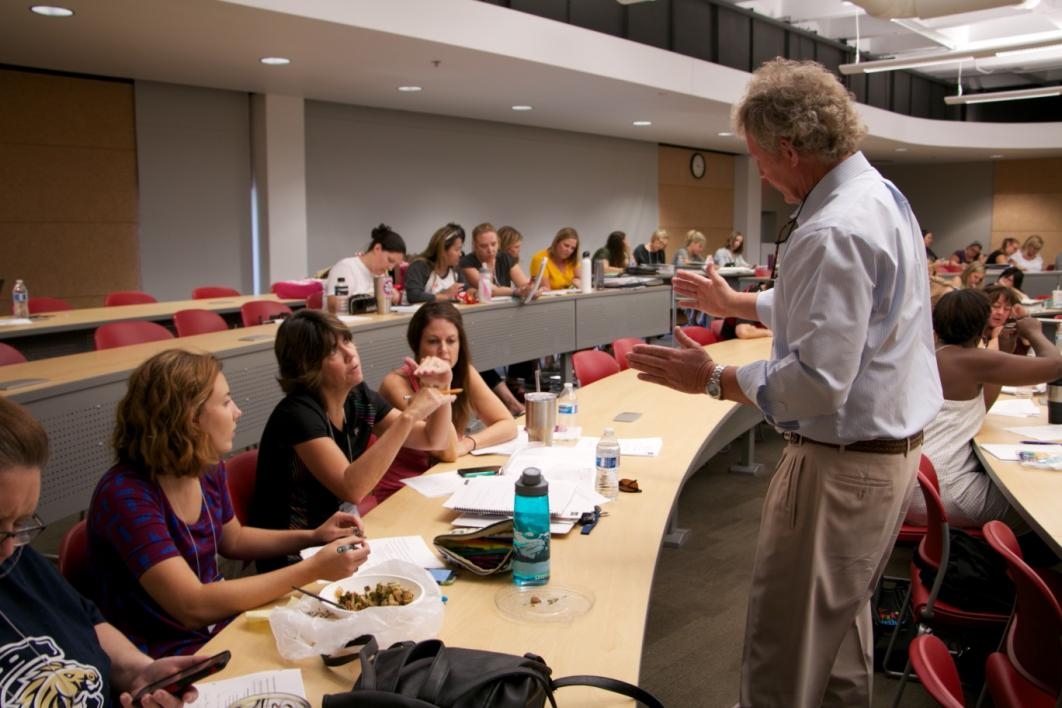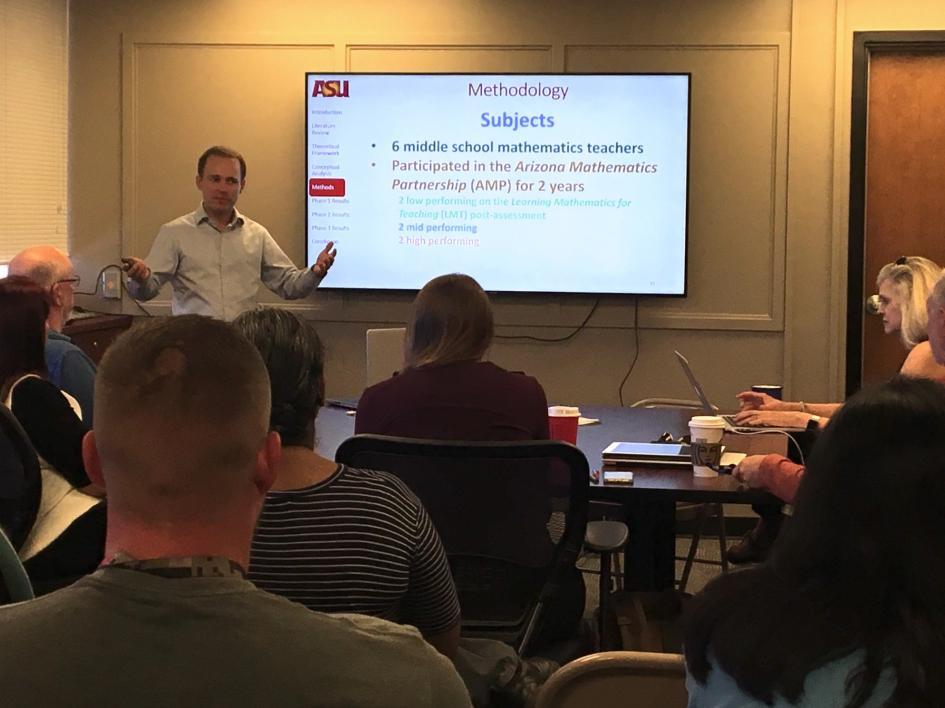Editor’s note: This is part of a series of profiles for spring 2019 commencement.
Matt Weber had earned his master’s degree and knew he enjoyed education and teaching but was feeling suffocated at his job. He was the only full-time mathematics faculty at a small college in Utah. There were no other math colleagues to interact with, and he wasn’t experiencing much professional growth.
“I felt a little bit like an eagle inside a cage,” Weber remembered. “I needed to spread my wings and my current job was not letting me do that.”
He applied for the PhD program in mathematics education at the School of Mathematical and Statistical Sciences at Arizona State University. He had heard of Pat Thompson and Marilyn Carlson, two well-recognized names in the field of mathematics education who had built the successful program at ASU.
A grant from the Arizona Mathematics Partnership (AMP) funded him as a research associate. AMP is part of a $9 million program funded by the National Science Foundation, conceived by principal investigator and ASU alumna April Strom.
AMP focused on professional development for middle school mathematics teachers. AMP also produced research to help understand teachers’ and students’ mathematical thinking and beliefs. Over 13,000 Arizona students were impacted by the AMP program.
“AMP really opened my eyes and affected the way I think about mathematics more than my classes at ASU did,” Weber said. “I was rubbing shoulders with lots of different PhDs who were sharing their wisdom with the middle school teachers, and I got to watch this over and over as a researcher, so some of those ideas really sunk in.”
Many of the people involved with AMP are alumni of ASU’s Mathematics Education PhD program, and were mentored by Marilyn Carlson. This included April Strom, Ted Coe, Judy Sutor, Frank Marfai, Trey Cox, Jim Vicich, Scott Adamson, and Kacie Joyner. “Marilyn Carlson changed the direction of our careers, and our philosophy about teaching changed,” explained Strom. ”We learned deeply, and we taught the teachers.”
Part of Weber’s research involvement with AMP included interviewing teachers and investigating what they understood about ideas related to multiplication and division, proportionality and measurement.
“That’s ultimately what paved the way for my dissertation. I remember the day when we had an epiphany. We gave a task to the teachers and a certain thing kept occurring. They were changing their way of thinking about division depending on the divisor.
"If it was a whole number, they drew one picture. But if it was a fraction, they drew a different picture. They didn’t realize they switched from partitive to quotative division. They didn’t even realize that was two different ways to think about division.”
Weber described an example in the context of whole numbers: 15 divided by three. He would ask each teacher to say what their meaning is and draw a picture of it. “Usually you will see something in the form of partitive, where they make three groups with five things in each group, which would give an answer of five,” explained Weber.
“Sometimes you would also see quotative meaning, how many threes make 15, and the answer is five. If they could show both ways, you could push and say, 'Do you realize these are both different?' And if they don’t see both ways, usually it’s an eye opener to them. ‘Wow, you’re right! I didn’t even realize I was switching,’" said Weber.
Weber then described an example using a fraction. He asked the teachers what is 15 split into 7/4 groups? “Usually you start to see some obstacles very quickly, about how they cope with non-whole number groups.”
In Weber’s dissertation, he discussed a teacher who was struggling. Given the problem of 4 divided by 1/3, she could only think quotatively (how many 1/3’s make four?) and kept answering with 12. Weber tried to get her to answer the question '1/3 copies of what makes four?', but she repeatedly said, ‘I can’t draw this.’
Eventually he used pizza as a reference, and described how you could eat 1/4 of it. The teacher drew a pizza circle, drew lines to cut it into four quarters and highlighted one. “If there were 12 pepperonis spread out evenly, how would you know how many pepperonis you would get on 1/4 of the pizza?,” he asked. The teacher was able to deduce and put 3 pepperonis on each quarter section of the pizza: 1/4 of 12 makes 3.
Weber suggested they reverse engineer this. “What if you know there were 3 pepperonis per slice, but you don’t know how many total pepperonis there were to begin with?,” he asked her. The teacher was able to take that context, reverse engineer it, and start thinking about 1/4 of a number becomes 3. She just couldn’t see that without Weber’s guiding. Eventually she realized there were multiple ways to think about it.
“Middle school teachers are put in a position to analyze the reasoning ability of their students, and some of these ways of thinking will arise naturally in their students,” Weber explained. “It would be a shame for a student to explain a division problem with a partitive conceptualization and for the teacher to say, ‘No, do it this way” because it doesn’t click for the teacher. Having awareness so they can recognize thinking in their students that’s valid thinking, and supporting that, versus snuffing it out and saying it’s wrong, I think is crucial for a teacher.”
“The goal is to make mathematics meaningful, and not magical, in the mind of the person.”
Weber received his PhD in Mathematics Education this May. We asked him a few questions about his experience here at ASU.
Question: What’s something you learned while at ASU — in the classroom or otherwise — that surprised you, that changed your perspective?
Answer: While at ASU I was introduced to, and have become a proponent of, constructivist philosophy, which was entirely new to me at the time.
Q: Tell us more about constructivist philosophy.
A: Constructivism is this idea that knowledge is constructed, and usually in unique ways. Two people can look at the same object but infer different things about it. It means one thing to one person, something else to a different person, but they are seeing the same thing. This idea is that people have, if you will, a set of blueprints that governs their mathematical thinking. When they see something, it triggers a certain set of instructions for them to act on that. And everyone’s blueprint is different, kind of like a fingerprint. We don’t all visualize the same thing in the same way. Truly understanding the way a person thinks is something that is not really knowable to an outside person. I can look at the evidence of what things you’re saying, the things that are observable, and then make judgment calls about what’s not observable going on in your head. That’s the challenge of this kind of research, is getting at the underlying mathematical meanings that people have.
I used to think of mathematics as very black and white. Like the way I see it is the way it is meant to be seen. It’s right or wrong, and I see it the right way. But I’ve since learned there is a lot of gray mathematics, a lot of different ways that people make sense of things, sometimes valid, sometimes invalid, but that work. Like gimmicky – I just do “this” every time and it works, and I get full credit. They think they have a mathematical understanding of something, but no, you’ve caught on to a gimmick that happens to work. With constructivism, I view so many things in life that way, all knowledge is like this. It was introduced to me in the context of mathematical learning but now I see it everywhere.
Q: Why did you choose ASU for your doctoral degree?
A: Three reasons: (1) the math education program was well known, (2) weather, and (3) my twin brother lives here.
Q: Why is mathematics education a great doctoral degree to pursue?
A: There is so much to do to improve the educational experiences of students in K-16 for mathematics in this country. If you are interested in researching learning theory, pedagogy, and student thinking, then come join the fun!
Q: Which professor taught you the most important lesson while at ASU?
A: Pat Thompson helped me to be careful in my thinking and writing regarding mathematical ideas by avoiding thinking about them and describing them in realist terms.
Q: What’s the best piece of advice you’d give to those still in graduate school?
A: Get good mentors and surround yourself with people dedicated to your success.
Q: What do you think is misunderstood about math by the general public?
A; That math is about memorizing and applying formulas, instead of about reasoning about quantities and modeling the world we live in.
Q: When not studying, what do you like to do for fun in your spare time?
A: Tennis, cooking, ultimate frisbee, piano, hiking, traveling.
Q: What are your plans after graduation?
A: Continuing to work in my current position (residential faculty member in the mathematics department at Glendale Community College), and aim to present at conferences and publish from my dissertation.
Also, my dad retired recently and he wants to ride a bike across the country. It’s called the Transamerica Trail, from Yorktown, Virginia, and then 4,300 miles later you end up in Astoria, Oregon.
Since I work on a nine-month contract I have my summer off, I said, 'I’ll join you.' May 14th we start the trail. It will be three months of survival — that’s it. Where’s the next food? Where’s the next water? Where’s the next place to sleep? ... as we slowly inch our way across the U.S. map. (You can follow their journey online.)
More Science and technology

ASU professor breeds new tomato variety, the 'Desert Dew'
In an era defined by climate volatility and resource scarcity, researchers are developing crops that can survive — and thrive —…

Science meets play: ASU researcher makes developmental science hands-on for families
On a Friday morning at the Edna Vihel Arts Center in Tempe, toddlers dip paint brushes into bright colors, decorating paper…

ASU water polo player defends the goal — and our data
Marie Rudasics is the last line of defense.Six players advance across the pool with a single objective in mind: making sure that…







